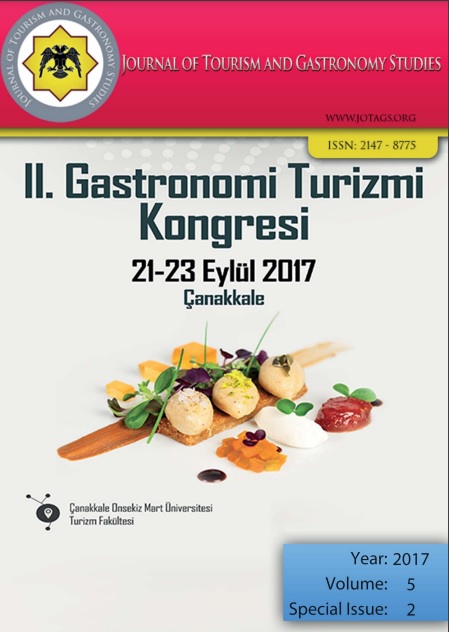The Perception of Physical Elements in Restaurants
Keywords:
Physical environment, Restaurants, Demographic features, İstanbulAbstract
This study aims to reveal whether there were significant differences among luxury restaurant customers’perceptions of physical environment elements in terms of their demographic features and purchase behavior. In this direction, this study focused the customers’ perceptions of physical environment elements of restaurants which are operated in İstanbul. 395 data were gathered at the end of the survey. Factor analysis, reliability and validity tests, t test and ANOVA were used to analyse the gathered data. According to the findings, ambience was determined as the most perceived physical environment element whereas table setting was found as the least perceived factor. The differences among customers’ age and expenditure amount and their perceptions of physical environment elements were also explored.
References
Ariffin, F. H.,Bibon, F. M. ve Abdullah Raja, S. P. R. (2012). Restaurant’s Atmospheric Elements: What The Customer Wants. Procedia-Social and Behavioral Sciences, 38, 380-387.
Akaydın, H. (2007). Perakende mağaza atmosferinin müşterilerin satın alma kararı üzerindeki rolü: Eskişehir ilindeki alışveriş merkezi müşterileri ile bir araştırma, (Yayınlanmamış Yüksek Lisans tezi), Sosyal Bilimler Enstitüsü, Eskişehir.
Ayazlar, G. ve Artuğer, S. (2015). Otel müşterileri için önemli olan atmosferik unsurların demografik özelliklere göre incelenmesi. Pamukkale Üniversitesi Sosyal Bilimler Enstitüsü Dergisi, 21, 25-33
Bekar, A. ve sürücü, Ç. (2015). Yiyecek İçecek İşletmesi Tasarımının Tüketici Tercihleri Üzerindeki Etkisi. Türkiye Sosyal Araştırmalar Dergisi, 1(1), 349-376.
Bitner, M.J. (1992). Servicescapes: The impact of physical surroundings on customers and employees. Journal of Marketing, 56, 57–71.
Fernandes, T., Proenca, J. ve Ramboca, M. (2013). Evaluating the impact of customer demographical characteristics on relationship outcomes, 22nd International Business Information Management Conference.
Hair J.F.,Black, W.C., Babin, B.J., Anderson, R.E. ve Tatham, R.L. (2006). Multivariate Data analysis(6. Basım). UpperSaddleRiver, NJ: PearsonPrenticeHall.
Hançer, M., Biçici, F. ve Tanrısevdi, A. (2007). Fiyat sonu yazım stratejileri: Kafe ve restoran menü fiyatlarının öğrenci algıları üzerindeki etkisini belirlemeye yönelik nitel bir çalışma, Anatolia: Turizm Araştırmaları Dergisi, 18(1), 21-32.
Kalaycı, Ş. (2006). Faktör Analizi SPSS Uygulamalı Çok Değişkenli İstatistik Teknikleri, Ankara: Asil Yayınevi.
Kayri, M. (2009). Araştırmalarda Gruplar Arası Farkın Belirlenmesine Yönelik Çoklu Karşılaştırma (POST-HOC) Teknikleri. Fırat Üniversitesi Sosyal Bilimler Dergisi, 19(1), 51-64.
Kotler, P. (1973). Atmospherics as a marketingtool. Journal of Retailing, 49(4), 48–64.
Kim, W.G. ve Moon, Y.J. (2009). Customers’ cognitive, emotional, and actionable response to the servicescape: a test of the moderating effect of the restaurant type. International Journal of Hospitality Management, 28, 144–156.
Kültür ve Turizm Bakanlığı (2005). Turizm Tesislerinin Belgelendirilmesine ve Niteliklerine İlişkin Yönetmeliğin Uygulanmasına Dair Tebliğ, http://teftis.kulturturizm.gov.tr/TR,14705/turizm-tesislerinin-belgelendirilmesineve-niteliklerin-.html Ulaşım Tarihi: 0.10.2017
Parasuraman, A.,Zeithaml, A.V. ve Berry, L.L. (1988). SERVQUAL: A multiple item scale for measuring consumer perceptions of service quality. Journal of Retailing, 64, 12–40.
Piotrowski, C.M ve Rogers, E.A. (2007). Designing Commercial Interiors, 2.baskı, John Wiley and Sons, New Jersey:Canada
Raajpoot, N. A. (2002). TANGSERV: A multiple item scale for measuring tangible quality in food service industry. Journal of Food Service Business Research, 5(2), 109-127.
Roxas, M. ve Stoneback, J. (2004). The importance of gender across cultures in ethical decision-making. Journal of Business Ethics, 50(2), 149-165.
Ryu, K., ve Jang, S. (2005). A multiple item scale for measuring the physical environment in upscale restaurants. İçinde Proceedings of the 2005 Asia Pacific TourismAssociation (APTA) Annual Conference, Goyang, Korea.
Ryu, K. ve Jang, S. (2007). The effect of environmental perceptions on behavioral intentions through emotions: The case of upscale restaurants. Journal of Hospitality & Tourism Research, 31(1), 56-72.
Ryu, K. ve Jang, S. S. (2008). DINESCAPE: A scale for customers’ perception of dining environments. Journal of Food Service Business Research, 11(1), 2-22.
Ryu, K. ve Han, H. (2011). New or repeat customers: How does physical environment influence their restaurant experience?. International Journal of Hospitality Management, 30(3), 599-611.
Stevens, P. Knutson, B. ve Patton, M. (1995). DINESERV: A tool for measuring service quality in restaurants. Cornell Hotel and Restaurant Administration Quarterly, 36, 56–60.
Sulek, J. M. ve Hensley, R. L. (2004). The relative importance of food, atmosphere, and fairness of wait: The case of a full-service restaurant. Cornell Hotel and Restaurant Administration Quarterly, 45(3), 235-247.
Turley, L. W. ve Milliman, R. E. (2000). Atmospheric effects on shopping behavior: A review of the experimental evidence. Journal of Business Research, 49(2), 193-211.
TUIK (2017). Yıllara göre il nüfusları, www.tuik.gov.tr Ulaşım tarihi: 23.06.2017
Tüzünkan, D. ve Albayrak, A. (2016). The importance of restaurant physical environment for Turkish customers. Journal of Tourism Research & Hospitality, 5(1), 1-7.
Yazıcıoğlu, Y. ve Erdoğan, S. (2007). SPSS uygulamalı bilimsel araştırma yöntemleri. Detay Yayıncılık.
Yoon, C. ve Cole, C. A. (2008). Aging and consumer behavior. İçinde Haugtvedt, Kardes, and Herr (Eds.), The
Hand book of Consumer Psychology. New York: Lawrence Erlbaum Associates, 247–272.
Wakefield, K. L. ve Blodgett, J. G. (1994). The importance of servicescapes in leisure service settings. Journal of Services Marketing, 8(3), 66-76.
Watson, L. (1990). Lighting design handbook, Mc Graw Hill Book Company, New York, London.
Downloads
Published
How to Cite
Issue
Section
License
Copyright (c) 2023 Journal of Tourism & Gastronomy Studies

This work is licensed under a Creative Commons Attribution-NonCommercial 4.0 International License.








